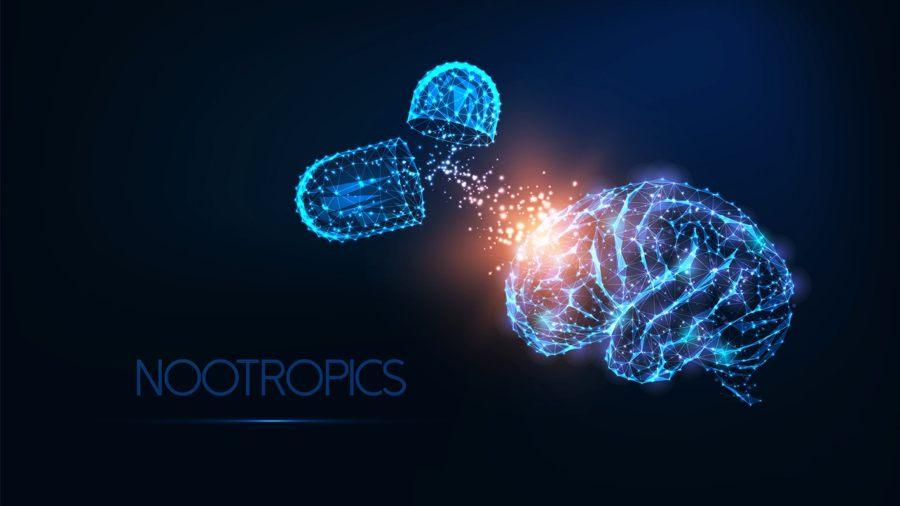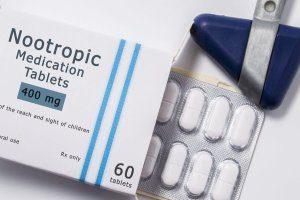
Nootropics
Nootropics are neurometabolic stimulants that have a positive effect on complexly organized psychophysiological processes. The mechanism of their action is associated with the restoration of the bioenergetic and metabolic functions of the neuron, as well as the neurotransmitter systems of the brain. The principle of operation of nootropic drugs, as their name implies, is aimed at improving the functioning of brain regions that are responsible for learning, memory, attention and other cognitive functions.
Nootropic drugs are drugs containing organic or synthetic active substances, as well as their derivatives that stimulate the work of neurotransmitters. They are grouped into a pharmacotherapeutic group with the ATX code N06BX (“Other psychostimulants and nootropic drugs”).
The term nootropics was coined in 1972 by Romanian chemist, psychologist and PhD Corneliu E. Giurgea, who first synthesized piracetam in 1964. Its therapeutic effect turned out to be the opposite of the chemist’s expectations — characteristic of psychostimulants, without the occurrence of non-core actions. This effect is still a mystery to scientists.
The nootropics currently used in medicine are represented in the international system of classification of medicines (Anatomical Therapeutic Chemical, ATC), adopted by the Ministry of Health of the Russian Federation in 2002. Other nootropic drugs are created for use within specific countries and are not marketed internationally.

Clinical use of nootropics
Psychiatrists and psychotherapists can prescribe nootropic drugs both as monotherapy and in combination with other psychotropic drugs. For example, nootropics are prescribed for the treatment of neurosis, attention deficit hyperactivity disorder (ADHD), depressive disorders and other mood disorders, and schizophrenia.
The purpose of prescribing nootropic drugs is to restore the cognitive functions of the brain responsible for the processes of interaction with received information, in particular:
perception (of information, — note, and further);
processing;
analysis;
memorization;
Storage;
correlations;
conclusions.
Nootropic drugs are also used in other areas of clinical medicine. For example, in pediatrics, where nootropics help to restore amino acid deficiency, which disrupts protein biosynthesis in the body and metabolic processes in general. In particular, a doctor may prescribe nootropics for children with signs of delayed speech and mental development, mental retardation, and the effects of perinatal damage to the central nervous system. Doctors of other specialties (speech therapists, neurologists, endocrinologists, gynecologists, urologists, ophthalmologists) can prescribe nootropics depending on the symptoms, including in complex therapy, for various diseases and conditions.:
neuroleptic syndrome;
stuttering, logoneurosis;
hyperkinesis, dyskinesia;
urinary disorders;
insomnia and other sleep disorders;
headaches of various etiologies;
dizziness;
seasickness;
open-angle glaucoma;
vascular diseases of the retina;
diseases of the macula;
diabetic retinopathy;
Alzheimer’s disease;
Parkinson’s disease;
Huntington’s disease;
with the consequences of TBI.
In other words, the range of use of nootropic drugs is wide and is not limited only to mental disorders. The gentle therapeutic mechanism of drugs in this group allows the administration of nootropics to newborns and infants, as well as the elderly. It is also important that nootropic drugs are included in the List of vital and essential medicines for medical use.
Mechanism of action of nootropic drugs
The mechanism of action of nootropics has not been fully studied to date. However, the principle underlying the therapeutic effect, which has been repeatedly confirmed in vivo, is still of interest to researchers in the field of biochemistry, cytology and pharmacology. In particular, researchers know that the effectiveness of nootropics in clinical medicine is associated with several mechanisms observed at the cellular level in the central nervous system.:
enhance the synthesis of ATP and its derivatives;
enhance the process of synaptic transmission in the central nervous system;
enhance the plastic process in the central nervous system by increasing the synthesis of RNA and proteins;
enhance the process of glucose utilization;
they have a mambranostabilizing and antioxidant effect.
Thus, the mechanism of action of nootropic drugs is associated with the restoration of metabolic and bioenergetic processes in the brain, which affect a person’s mood, performance, and well-being. A properly selected nootropin will have the effects necessary for treatment, which are manifested over a long distance, provided that the recommendations of the attending physician are followed (for example, regarding a rational and healthy lifestyle, attending psychotherapy sessions, taking first-line medications).
The effectiveness of nootropics
The effectiveness of nootropics, in particular, is explained by the therapeutic effect on the neurotransmitter systems of the brain — monoaminergic, cholinergic and glutamatergic. Nootropics help to restore the regulation of phospholipid and protein synthesis in neurons, normalize the structures of cell membranes; reduce the need for oxygen in neurons; suppress the formation of free radicals and lipid peroxidation of cell membranes; increase the protection of neurons against adverse factors affecting their proper functioning.
The results of biochemical blood analysis and EEG, as well as laboratory experiments using modern microscopes, make it possible to visualize the effectiveness of nootropics. For example, the results of an electroencephalogram can clearly show the effect of using nootropics — increased amplitudes of transcallosal evoked potentials, an enhanced EEG power spectrum of the cortex and hippocampus, an increased dominant peak, smoothed interhemispheric asymmetry.
Monoamine neurotransmitters
Classical monoamines include: histamine, adrenaline, dopamine, norepinephrine, serotonin, melatonin. Monoamine neurotransmitters and neuromodulators act as neurotransmitters in the monoaminergic systems of the central nervous system, which regulate various processes in the body, including:
emotional state;
cognitive activity;
concentration of attention;
the ability to memorize information;
arousal processes.
Cholinergic neurotransmitters
Cholinergic neurotransmitters in the central nervous system are responsible for the processes of excitation and inhibition in the body. Neurotransmitters of this CNS system support the autonomous functioning of internal organs and vital processes related to the work of innervated organs, and are involved in the transmission of impulses of motor activity. Cholinergic deficiency directly affects the imbalance of the CNS structures associated with it and can cause the development of:
neurological symptoms;
emotional-volitional pathology.
Glutamatergic neurotransmitters
Glutamatergic neurotransmitters are involved in the processes of the central nervous system related to cognitive function — they help process and store information. In addition, these neurotransmitters are responsible for motor coordination, pain response, and the body’s immune response; they are responsible for the quality of nerve impulse transmission and the state of the nervous system as a whole.
Nootropics for children, adults and the elderly
Currently, clinical studies of nootropics are being conducted in the USA and Europe in order to identify therapeutic effects that can be used to treat diseases in various fields of medicine. It should be emphasized that it is possible to talk about nootropics with proven effectiveness only in terms of the positive mechanism of their action, which is recorded by both researchers and doctors in clinical practice.
For example, on February 12, 2010, data from a clinical study on the use of nootropics in the treatment of CNS pathology were published in the United States (Malykh A., Sadaie R. “Piracetam and piracetam-like drugs: from basic science to novel clinical applications to CNS disorders”). The study demonstrated the neuroprotective effect of the substance, its effectiveness in the treatment of cognitive disorders of cerebrovascular and traumatic etiology, as well as related depressive states. In particular, the study notes the effectiveness of nootropics as part of complex therapy in the treatment of epilepsy.
Similar and other positive effects of the use of nootropics are noted in many modern clinical trials, the results of which are published in scientific journals and are publicly available on the Internet. In other words, nootropics with proven effectiveness exist, they are represented on the pharmaceutical market, and are actively prescribed by doctors in various fields of medicine, but the final interpretation of the therapeutic mechanism of drugs in this group has yet to be found out.
Nootropics are used in the treatment of various diseases associated with the pathology of the central nervous system in children. In the early years of a child’s life, they can be prescribed for the prevention and treatment of delayed psycho-speech-motor development; at a later age, they can stimulate the activity of the central nervous system systems responsible for concentration, learning, memory, and the ability to reproduce information.
Nootropics for children include drugs with dominant or predominant mnestic effects (“true” nootropics):
racetams;
cholinesterase drugs;
neuropeptides and their analogues;
amino acid activators;
neuroprotectors;
brain metabolism activators;
cerebral vasodilators;
calcium antagonists;
antioxidants;
GABA activators.
